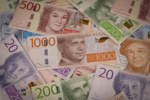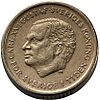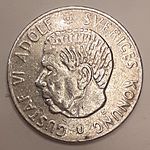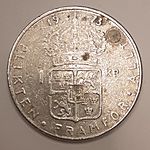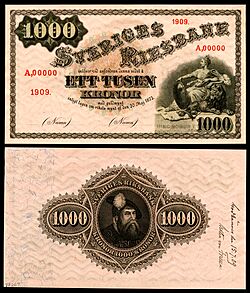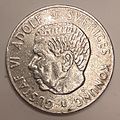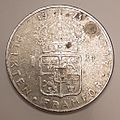Swedish krona facts for kids
Quick facts for kids Swedish krona |
|||||
|---|---|---|---|---|---|
|
|||||
| ISO 4217 Code | SEK | ||||
| User(s) | |||||
| Inflation | 3.3% (target 2.0%) | ||||
| Source | November 2023 | ||||
| Method | CPI | ||||
| Subunit | |||||
| 1⁄100 | öre | ||||
| Symbol | kr | ||||
| Nickname | spänn; riksdaler; crowns (English); lax/lakan/lök, papp, (rarely) bagare/bagis (1000 kr); röding (500 kr) | ||||
| Plural | kronor | ||||
| öre | öre/ören | ||||
| Coins | 1, 2, 5, 10 kr | ||||
| Banknotes | |||||
| Freq. used | 20 kr, 50 kr, 100 kr, 200 kr, 500 kr | ||||
| Rarely used | 1000 kr | ||||
| Printer | None as of 19 June 2018 | ||||
The krona (pronounced "kroo-na") is the money used in Sweden. Its symbol is kr, and its international code is SEK. You might also hear it called the Swedish crown because "krona" means "crown" in Swedish.
One krona used to be divided into 100 öre. However, coins smaller than 1 krona, like the öre, are no longer used. Even though items can still be priced in öre, the total amount is always rounded to the nearest krona when you pay with cash. The word öre comes from an old Latin word for gold.
Contents
History of the Swedish Krona
The krona was first introduced in 1876. It replaced an older currency called the Swedish riksdaler. This change happened because of something called the Scandinavian Monetary Union. This union was an agreement between Sweden, Denmark, and Norway. They all decided to use money with names meaning "crown" (krona in Sweden, krone in Denmark and Norway).
At that time, their money was linked to gold. This meant a certain amount of kronor or kroner could always buy a specific amount of pure gold. This system worked until World War I started. After the war, the link to gold was stopped, and the value of the currencies started to change against each other.
Swedish Coins
New Coins (Since 2016)
In 2016, Sweden introduced a brand new set of coins. These new coins replaced the older 1-krona and 5-kronor coins. They also brought back the 2-kronor coin, which hadn't been made since 1971. The 10-kronor coin stayed the same.
The new coin designs are inspired by a Swedish song called "Sun, Wind and Water." Each coin shows one of these elements. Another reason for the new coins was to stop using nickel in them, which can cause allergies for some people. Also, many vending machines and parking meters in Sweden now only accept bank cards or mobile phone payments, not coins.
| Value | Diameter | Thickness | Weight | What it's made of | First made in | How many are in use | Total value |
|---|---|---|---|---|---|---|---|
| 1 krona | 19.5 mm | 1.79 mm | 3.6 g | Copper-plated steel | 2016 | 190 million | 190 million |
| 2 kronor | 22.5 mm | 1.79 mm | 4.8 g | Copper-plated steel | 2016 | 331 million | 662 million |
| 5 kronor | 23.75 mm | 1.95 mm | 6.1 g | Nordic gold | 2016 | 482 million | 2,410 million |
| 10 kronor | 20.5 mm | 2.9 mm | 6.6 g | Nordic gold | 1991 | 2,095 million | 20,950 million |
| Nordic gold is a mix of 89% copper, 5% aluminum, 5% zinc, and 1% tin. | |||||||
Coin History
When the krona was first introduced in the 1870s, there were coins for 1, 2, 5, 10, 25, and 50 öre, and 1, 2, 10, and 20 kronor. Some were made of bronze, some of silver, and the 10 and 20 kronor were made of gold!
Over the years, the materials used for coins changed, especially during World War I and World War II, when metals were scarce. For example, iron was used instead of bronze for a while. Also, the amount of silver in coins was reduced.
In 1968, the 1-krona and 2-kronor coins started to be made of different metals. Interestingly, all 1-krona coins made since 1875 and 2-kronor coins made since 1876 were still legal to use until 2017! However, many of the older 2-kronor coins, especially those made before 1966, contained a lot of silver. This made them worth more than their face value, so many were melted down.
Since 1972, the 5-kronor coin has been smaller. The design we see today has been around since 1976. Older 5-kronor coins that contained silver are still legal to use, but collectors often keep them because of their silver content.
Many Swedish coins also have the king's royal motto written on them.
Cash Rounding
Because smaller öre coins were removed from circulation over time, Sweden introduced something called Cash rounding, or "Swedish rounding." This means that when you pay with cash, the total amount is rounded up or down to the nearest krona. For example:
- In 1971, 1- and 2-öre coins were removed, so payments were rounded to the nearest 5-öre.
- By 2010, the 50-öre coin was removed. Now, cash payments are rounded to the nearest 1-krona.
All kronor coins made before the new series in 2016 are no longer valid money since 2017. You can't use them to pay, and banks won't exchange them. They are meant to be recycled!
Swedish Banknotes
Current Banknotes
Sweden's current banknotes are part of a series called Cultural Journey. They feature famous Swedish people and beautiful places or symbols from Sweden.
| Image | Value | Dimensions | Main color | Description | |||
|---|---|---|---|---|---|---|---|
| Front | Back | Front | Back | ||||
| [1] | [2] | 20 kronor | 120 × 66 mm | Purple | Astrid Lindgren (writer), Pippi Longstocking, Three Crowns | Småland (region), Linnaea (flower) | |
| [3] | [4] | 50 kronor | 126 × 66 mm | Orange | Evert Taube (singer), Three Crowns | Bohuslän (region), Rock Carvings in Tanum, Honeysuckle | |
| [5] | [6] | 100 kronor | 133 × 66 mm | Blue | Greta Garbo (actress), Three Crowns | Stockholm (city) | |
| [7] | [8] | 200 kronor | 140 × 66 mm | Green | Ingmar Bergman (director), Three Crowns | Gotland (island), Rauks (sea stacks) | |
| [9] | [10] | 500 kronor | 147 × 66 mm | Red | Birgit Nilsson (opera singer), Three Crowns | Öresund Bridge, Ox-eye daisy, Skåne (region) | |
| [11] | [12] | 1,000 kronor | 154 × 66 mm | Brown | Dag Hammarskjöld (diplomat), United Nations Secretariat Building, Flag of the United Nations, Three Crowns | Laponian area, Lappland (region) | |
| For table standards, see the banknote specification table. | |||||||
Banknote History
The first krona banknotes were issued in 1874 by the Sveriges Riksbank (Sweden's central bank). They came in values like 1, 5, 10, 50, 100, and 1,000 kronor. Even 10,000-kronor notes were printed in 1939 and 1958, but these were very rare.
Over the years, some banknote values were stopped and new ones were introduced. For example, the 5-kronor note stopped being made in 1981, and the 10-kronor note stopped in 1991 when a 10-krona coin was introduced. A new 20-kronor note was then created.
Older banknotes are eventually declared invalid, meaning they can no longer be used for payments. However, you can usually deposit these old banknotes into a bank account at the Riksbank for a fee.
The most recent series of banknotes started being released in 2015 and 2016. These new notes feature famous Swedes like writer Astrid Lindgren and actress Greta Garbo. They also include a new 200-kronor banknote.
Exchange Rate
The exchange rate shows how much one currency is worth compared to another. For example, how many Swedish kronor you need to buy one Euro. The value of the Swedish krona changes depending on Sweden's economic policies.
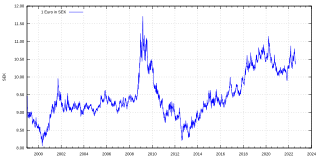
The krona has changed a lot against the Euro since the Euro was introduced. For instance, in 2009, one Euro was worth about 11.65 kronor, which was a weak point for the krona. In 2012, the krona was stronger, with one Euro costing about 8.21 kronor. This change was partly due to economic problems in other European countries.
Sweden and the Euro
Sweden is part of the European Union, and according to an agreement from 1994, it is supposed to join the eurozone and start using the euro. However, in 2003, the Swedish people voted in a special election, and most of them (56%) said no to adopting the euro.
Because of this vote, the Swedish government has found a way to avoid using the euro for now. One of the rules for joining the euro is that a country must be part of a special exchange rate system for two years. By simply not joining this system, Sweden can avoid the requirement to switch to the euro.
Even though some political parties in Sweden think it would be good to join the euro, all major parties have promised to respect the results of the 2003 vote. So, for now, Sweden continues to use its own currency, the krona.
Cash in Sweden
Sweden used to have a lot of banknotes and coins in circulation per person. But this has changed a lot. In the early 1990s, the largest banknote, the 10,000 kronor note, was removed from use.
Unlike some countries, Sweden often declares older banknotes and coins invalid after a certain date. This means they can no longer be used for payments. However, you can usually still deposit these old notes at the Riksbank.
The amount of cash used in Sweden has been going down a lot. This is partly because of new security features on banknotes, which made older notes invalid. Also, a popular mobile payment system called Swish was launched in 2012. Many people in Sweden use Swish instead of cash.
Sweden is unique because it is reducing its cash use much faster than many other countries. Many businesses in Sweden no longer accept cash, and cash machines are being removed, especially in rural areas.
The e-krona
The e-krona is a new idea for an electronic currency that could be issued directly by the Riksbank. It would be different from using your bank card because it would be central bank money, which means it has no risk of your bank going out of business.
The Riksbank is looking into creating an e-krona because cash use is declining so quickly in Sweden. If the e-krona is created, it would not replace physical cash but would be an additional way to pay. The Riksbank has said it will continue to issue banknotes and coins as long as people want them.
In 2020, the Swedish government started a review to see if moving to a digital currency is possible. This study was expected to finish by the end of 2022, but no decision has been made yet.
See also
 In Spanish: Corona sueca para niños
In Spanish: Corona sueca para niños
- Economy of Sweden
- List of currencies in Europe
- Scandinavian Monetary Union
Images for kids


